8.12: Algae
- Page ID
- 1475
\( \newcommand{\vecs}[1]{\overset { \scriptstyle \rightharpoonup} {\mathbf{#1}} } \)
\( \newcommand{\vecd}[1]{\overset{-\!-\!\rightharpoonup}{\vphantom{a}\smash {#1}}} \)
\( \newcommand{\dsum}{\displaystyle\sum\limits} \)
\( \newcommand{\dint}{\displaystyle\int\limits} \)
\( \newcommand{\dlim}{\displaystyle\lim\limits} \)
\( \newcommand{\id}{\mathrm{id}}\) \( \newcommand{\Span}{\mathrm{span}}\)
( \newcommand{\kernel}{\mathrm{null}\,}\) \( \newcommand{\range}{\mathrm{range}\,}\)
\( \newcommand{\RealPart}{\mathrm{Re}}\) \( \newcommand{\ImaginaryPart}{\mathrm{Im}}\)
\( \newcommand{\Argument}{\mathrm{Arg}}\) \( \newcommand{\norm}[1]{\| #1 \|}\)
\( \newcommand{\inner}[2]{\langle #1, #2 \rangle}\)
\( \newcommand{\Span}{\mathrm{span}}\)
\( \newcommand{\id}{\mathrm{id}}\)
\( \newcommand{\Span}{\mathrm{span}}\)
\( \newcommand{\kernel}{\mathrm{null}\,}\)
\( \newcommand{\range}{\mathrm{range}\,}\)
\( \newcommand{\RealPart}{\mathrm{Re}}\)
\( \newcommand{\ImaginaryPart}{\mathrm{Im}}\)
\( \newcommand{\Argument}{\mathrm{Arg}}\)
\( \newcommand{\norm}[1]{\| #1 \|}\)
\( \newcommand{\inner}[2]{\langle #1, #2 \rangle}\)
\( \newcommand{\Span}{\mathrm{span}}\) \( \newcommand{\AA}{\unicode[.8,0]{x212B}}\)
\( \newcommand{\vectorA}[1]{\vec{#1}} % arrow\)
\( \newcommand{\vectorAt}[1]{\vec{\text{#1}}} % arrow\)
\( \newcommand{\vectorB}[1]{\overset { \scriptstyle \rightharpoonup} {\mathbf{#1}} } \)
\( \newcommand{\vectorC}[1]{\textbf{#1}} \)
\( \newcommand{\vectorD}[1]{\overrightarrow{#1}} \)
\( \newcommand{\vectorDt}[1]{\overrightarrow{\text{#1}}} \)
\( \newcommand{\vectE}[1]{\overset{-\!-\!\rightharpoonup}{\vphantom{a}\smash{\mathbf {#1}}}} \)
\( \newcommand{\vecs}[1]{\overset { \scriptstyle \rightharpoonup} {\mathbf{#1}} } \)
\( \newcommand{\vecd}[1]{\overset{-\!-\!\rightharpoonup}{\vphantom{a}\smash {#1}}} \)
\(\newcommand{\avec}{\mathbf a}\) \(\newcommand{\bvec}{\mathbf b}\) \(\newcommand{\cvec}{\mathbf c}\) \(\newcommand{\dvec}{\mathbf d}\) \(\newcommand{\dtil}{\widetilde{\mathbf d}}\) \(\newcommand{\evec}{\mathbf e}\) \(\newcommand{\fvec}{\mathbf f}\) \(\newcommand{\nvec}{\mathbf n}\) \(\newcommand{\pvec}{\mathbf p}\) \(\newcommand{\qvec}{\mathbf q}\) \(\newcommand{\svec}{\mathbf s}\) \(\newcommand{\tvec}{\mathbf t}\) \(\newcommand{\uvec}{\mathbf u}\) \(\newcommand{\vvec}{\mathbf v}\) \(\newcommand{\wvec}{\mathbf w}\) \(\newcommand{\xvec}{\mathbf x}\) \(\newcommand{\yvec}{\mathbf y}\) \(\newcommand{\zvec}{\mathbf z}\) \(\newcommand{\rvec}{\mathbf r}\) \(\newcommand{\mvec}{\mathbf m}\) \(\newcommand{\zerovec}{\mathbf 0}\) \(\newcommand{\onevec}{\mathbf 1}\) \(\newcommand{\real}{\mathbb R}\) \(\newcommand{\twovec}[2]{\left[\begin{array}{r}#1 \\ #2 \end{array}\right]}\) \(\newcommand{\ctwovec}[2]{\left[\begin{array}{c}#1 \\ #2 \end{array}\right]}\) \(\newcommand{\threevec}[3]{\left[\begin{array}{r}#1 \\ #2 \\ #3 \end{array}\right]}\) \(\newcommand{\cthreevec}[3]{\left[\begin{array}{c}#1 \\ #2 \\ #3 \end{array}\right]}\) \(\newcommand{\fourvec}[4]{\left[\begin{array}{r}#1 \\ #2 \\ #3 \\ #4 \end{array}\right]}\) \(\newcommand{\cfourvec}[4]{\left[\begin{array}{c}#1 \\ #2 \\ #3 \\ #4 \end{array}\right]}\) \(\newcommand{\fivevec}[5]{\left[\begin{array}{r}#1 \\ #2 \\ #3 \\ #4 \\ #5 \\ \end{array}\right]}\) \(\newcommand{\cfivevec}[5]{\left[\begin{array}{c}#1 \\ #2 \\ #3 \\ #4 \\ #5 \\ \end{array}\right]}\) \(\newcommand{\mattwo}[4]{\left[\begin{array}{rr}#1 \amp #2 \\ #3 \amp #4 \\ \end{array}\right]}\) \(\newcommand{\laspan}[1]{\text{Span}\{#1\}}\) \(\newcommand{\bcal}{\cal B}\) \(\newcommand{\ccal}{\cal C}\) \(\newcommand{\scal}{\cal S}\) \(\newcommand{\wcal}{\cal W}\) \(\newcommand{\ecal}{\cal E}\) \(\newcommand{\coords}[2]{\left\{#1\right\}_{#2}}\) \(\newcommand{\gray}[1]{\color{gray}{#1}}\) \(\newcommand{\lgray}[1]{\color{lightgray}{#1}}\) \(\newcommand{\rank}{\operatorname{rank}}\) \(\newcommand{\row}{\text{Row}}\) \(\newcommand{\col}{\text{Col}}\) \(\renewcommand{\row}{\text{Row}}\) \(\newcommand{\nul}{\text{Nul}}\) \(\newcommand{\var}{\text{Var}}\) \(\newcommand{\corr}{\text{corr}}\) \(\newcommand{\len}[1]{\left|#1\right|}\) \(\newcommand{\bbar}{\overline{\bvec}}\) \(\newcommand{\bhat}{\widehat{\bvec}}\) \(\newcommand{\bperp}{\bvec^\perp}\) \(\newcommand{\xhat}{\widehat{\xvec}}\) \(\newcommand{\vhat}{\widehat{\vvec}}\) \(\newcommand{\uhat}{\widehat{\uvec}}\) \(\newcommand{\what}{\widehat{\wvec}}\) \(\newcommand{\Sighat}{\widehat{\Sigma}}\) \(\newcommand{\lt}{<}\) \(\newcommand{\gt}{>}\) \(\newcommand{\amp}{&}\) \(\definecolor{fillinmathshade}{gray}{0.9}\)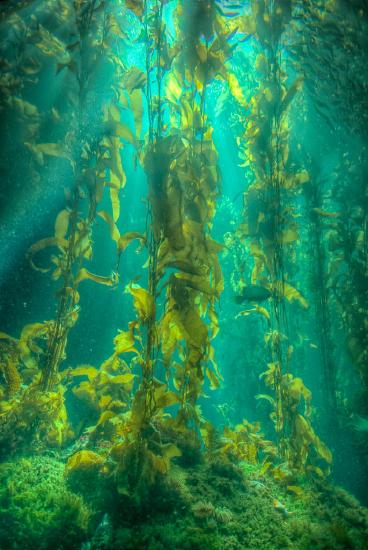
Many people, if not most, believe seaweed to be a plant. Is it?
Seaweed is actually a plant-like protist, which are also known as algae. The green color is due to what pigment? Algae, like plants, obtain their energy through photosynthesis.
Plant-Like Protists: Algae
Plant-like protists are called algae (singular, alga). They are a large and diverse group. Some algae, the diatoms, are single-celled. Others, such as seaweed, are multicellular (see Figure below).
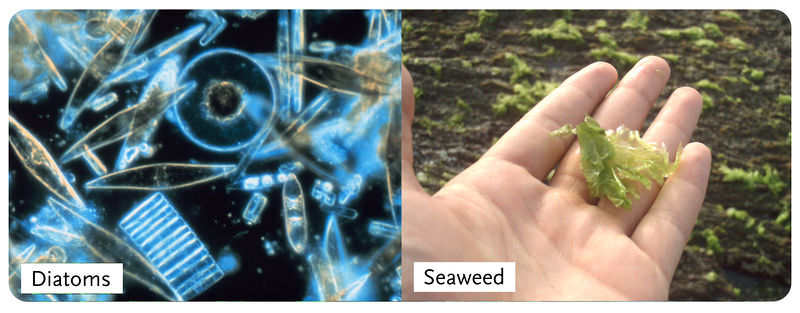 Diatoms are single-celled algae. Other forms of algae are multicellular.
Diatoms are single-celled algae. Other forms of algae are multicellular.Why are algae considered plant-like? The main reason is that they contain chloroplasts and produce food through photosynthesis. However, they lack many other structures of true plants. For example, algae do not have roots, stems, or leaves. Some algae also differ from plants in being motile. They may move with pseudopods or flagella. Although not plants themselves, algae were probably the ancestors of plants.
Ecology of Algae
Algae play significant roles as producers in aquatic ecosystems. Microscopic forms live suspended in the water column. They are the main component of phytoplankton. As such, they contribute to the food base of most marine ecosystems.
Multicellular seaweeds called kelp may grow as large as trees. They are the food base of ecosystems called kelp forests (see Figure below). Kelp forests are found throughout the ocean in temperate and arctic climates. They are highly productive ecosystems.
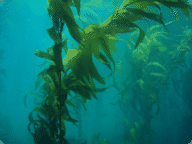 Kelp Forest. This kelp forest supports a large community of many other types of organisms.
Kelp Forest. This kelp forest supports a large community of many other types of organisms.Classification of Algae
Types of algae include red and green algae, and euglenids, and dinoflagellates (see Table below for examples). Scientists think that red and green algae evolved from endosymbiotic relationships with cyanobacteria. Their chloroplasts have two membranes because the cell membranes of the cyanobacteria became additional plasma membranes of the chloroplasts. Scientists think that euglenids and dinoflagellates evolved later, from endosymbiotic relationships with green and red algae. This is why their chloroplasts have three membranes. Differences in the types of chlorophyll in the four types of algae also support the hypothesized evolutionary relationships.
| Type of Algae | Origin of Chloroplast | Type of Chloroplast |
|---|---|---|
|
Red algae 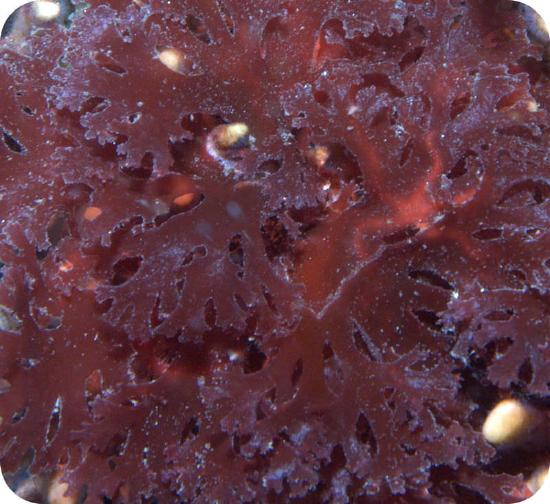 |
cyanobacteria | two membranes, chlorophyll like the majority of cyanobacteria |
|
Green algae 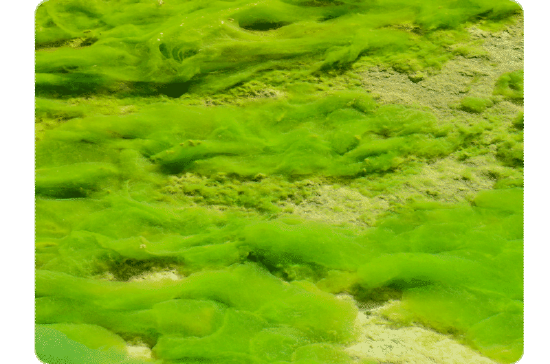 |
cyanobacteria | two membranes, chlorophyll like a minority of cyanobacteria |
|
Euglenids 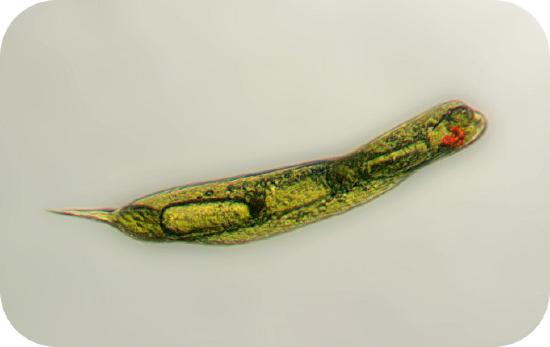 |
green algae | three membranes, chlorophyll like green algae |
|
Dinoflagellates  |
red algae | three membranes, chlorophyll like red algae |
Reproduction of Algae
Algae have varied life cycles. Two examples are shown in Figure below. Both cycles include phases of asexual reproduction (haploid, n) and sexual reproduction (diploid, 2n). Why go to so much trouble to reproduce? Asexual reproduction is fast, but it doesn’t create new genetic variation. Sexual reproduction is more complicated and risky, but it creates new gene combinations. Each strategy may work better under different conditions. Rapid population growth (asexual reproduction) is adaptive when conditions are favorable. Genetic variation (sexual reproduction) helps ensure that some organisms will survive if the environment changes.
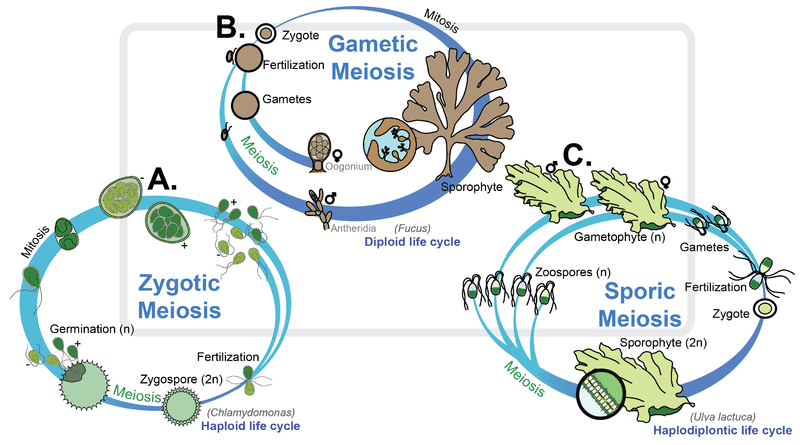
Life Cycles of Algae: Zygotic Meiosis (A), Gametic Meiosis (B) and Sporic Meiosis (C). In life cycle A (left), diploid (2n) zygotes result from fertilization and then undergo meiosis to produce haploid (n) gametes. The gametes undergo mitosis and produce many additional copies of themselves. How are life cycles B and C different from life cycle A?
KQED: Algae Power
QUEST explores the potential of algae-–once considered nothing more than pond scum–-to become the fuel of the future. Entrepreneurs from throughout California are working to create the next generation of biofuels from algae. But will you ever be able to run your car off it?
Summary
- Plant-like protists are called algae. They include single-celled diatoms and multicellular seaweed.
- Like plants, algae contain chlorophyll and make food by photosynthesis.
- Types of algae include red and green algae, euglenids, and dinoflagellates.
Review
- Compare and contrast algae and plants.
- State pros and cons of asexual and sexual reproduction in algae.
- Explain why dinoflagellates and euglenids have chloroplasts with three membranes instead of two.
| Image | Reference | Attributions |
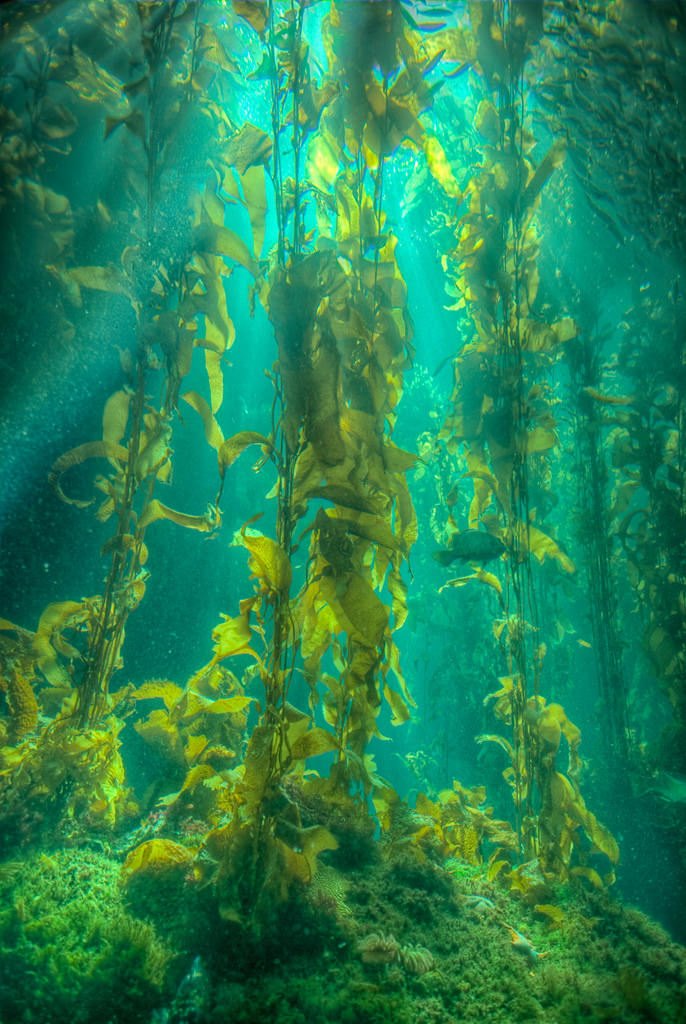 |
[Figure 1] | Credit: Mariana Ruiz Villarreal (LadyofHats) for CK-12 Foundation Source: CK-12 Foundation License: CC BY-NC |
 |
[Figure 2] | Credit: Diatoms: Courtesy of Prof. Gordon T. Taylor, NOAA; Seaweed: Wilfredo R Rodriguez H Source: Diatoms: commons.wikimedia.org/wiki/File:Diatoms_through_the_microscope.jpg ; Seaweed: commons.wikimedia.org/wiki/File:Alga_Marina.JPG License: Public Domain |
 |
[Figure 3] | Credit: Claire Fackler, NOAA Source: commons.wikimedia.org/wiki/File:Sanc0063_-_Flickr_-_NOAA_Photo_Library.jpg License: CC BY 2.0 |
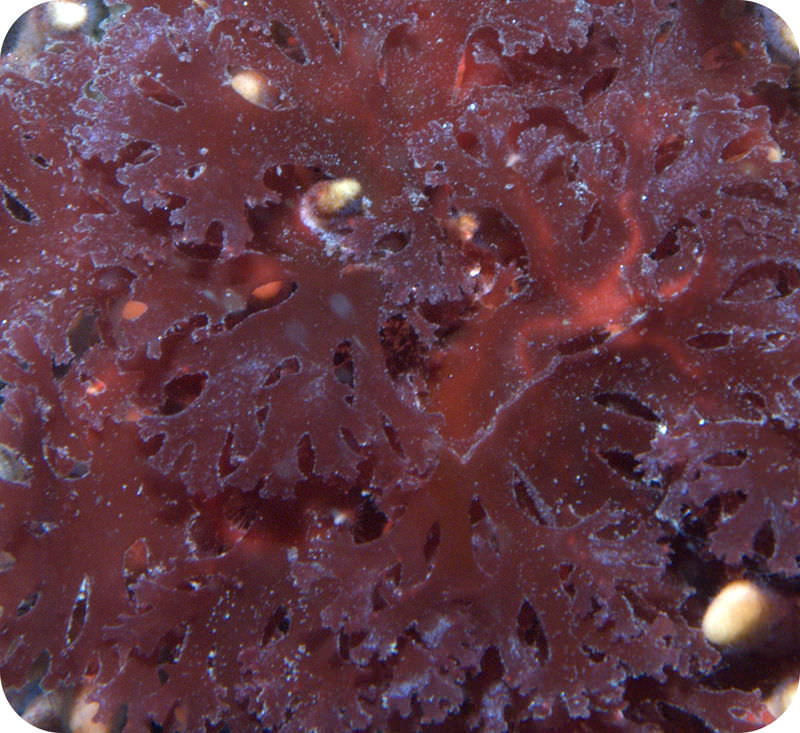 |
[Figure 4] | License: CC BY-NC |
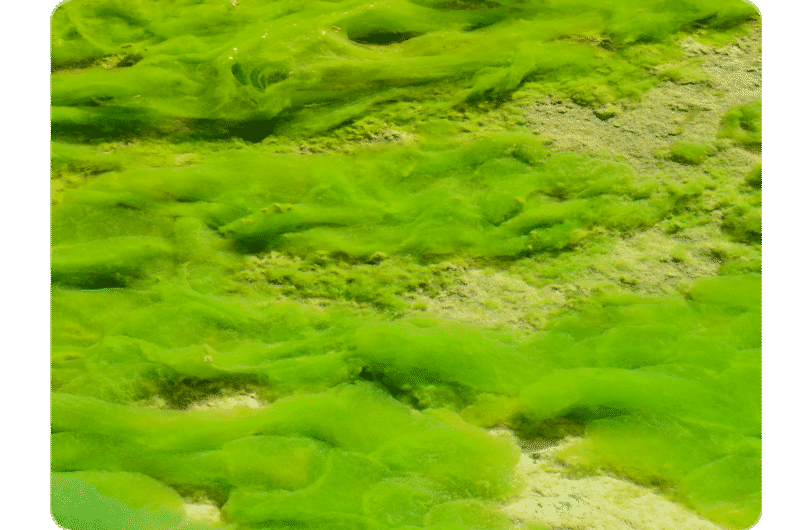 |
[Figure 5] | License: CC BY-NC |
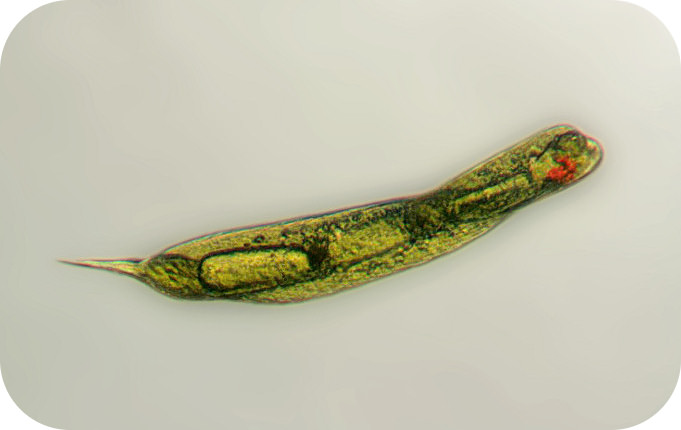 |
[Figure 6] | License: CC BY-NC |
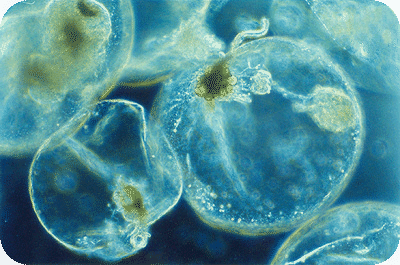 |
[Figure 7] | License: CC BY-NC |
 |
[Figure 8] | Credit: Mariana Ruiz Villarreal (LadyofHats) for CK-12 Foundation Source: CK-12 Foundation License: CC BY-NC 3.0 |

